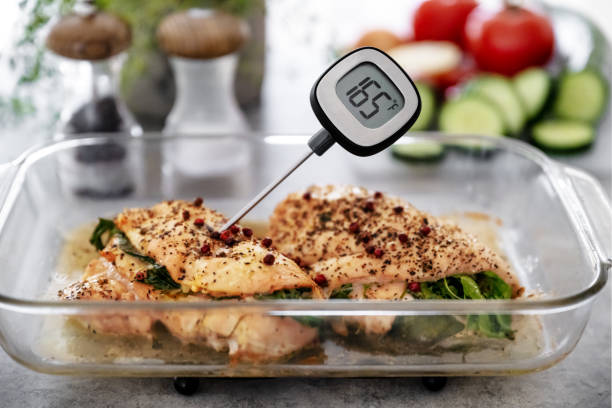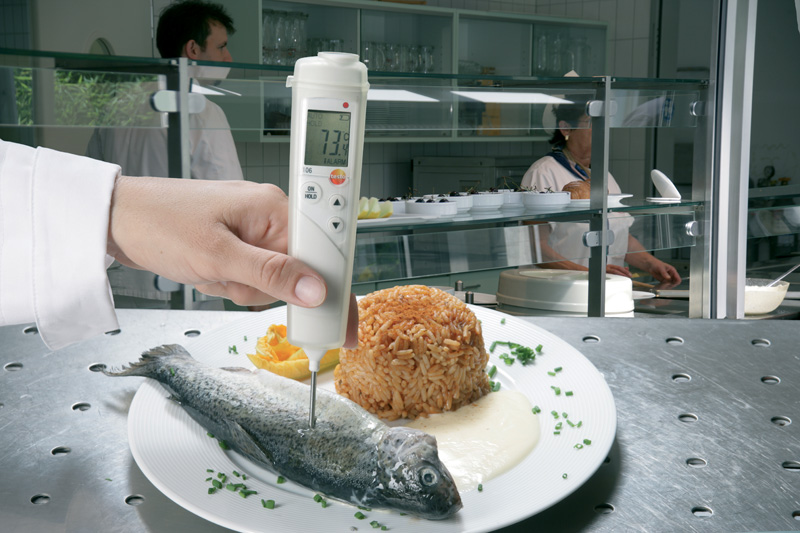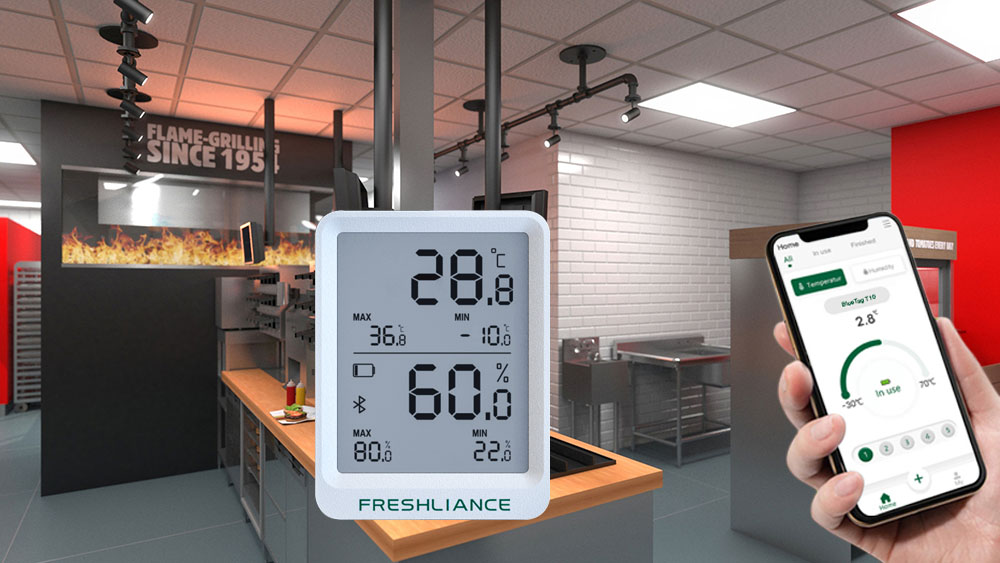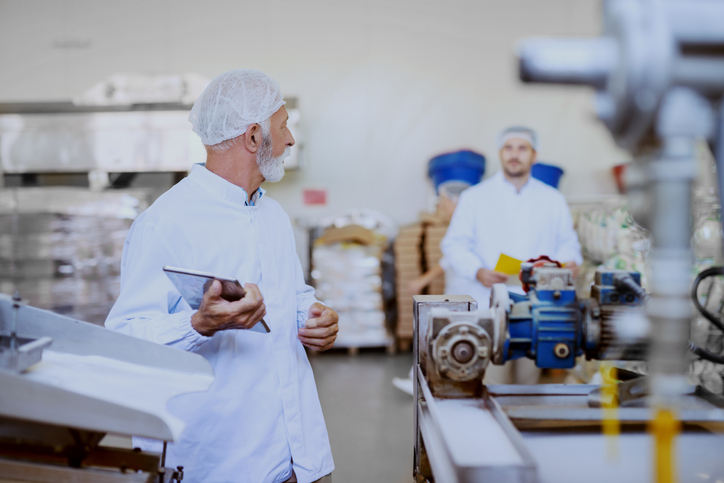Why Is Temperature Monitoring Crucial for Food Safety in Restaurants?
Restaurant temperature monitoring is a critical part of effective food safety practices. It directly affects your restaurant’s ability to keep customers safe from harmful bacteria and contamination. The “danger zone” temperature range of 4°C to 60°C is where bacteria can grow rapidly, making it crucial to control temperatures accurately in order to prevent foodborne illnesses.
By maintaining the right temperatures in your cold storage, refrigeration units, and hot holding equipment, you greatly reduce the risk of dangerous pathogens like Salmonella, E. coli, and Listeria multiplying. Even a small temperature change can ruin large amounts of ingredients, resulting in expensive waste and potential health risks for your customers.
How Modern Technology Enhances Temperature Monitoring
Modern food service temperature monitoring systems have advanced beyond simple thermometers to include sophisticated digital solutions:
- Temperature sensors and probes strategically placed throughout storage areas
- Wireless monitoring systems providing real-time data across multiple locations
- Digital logging software automatically recording and organising temperature data
- Alert systems notifying staff immediately when temperatures drift outside safe ranges
These tools work together to create a comprehensive safety net, ensuring you maintain consistent temperatures 24/7. The integration of automated monitoring eliminates human error in manual checks while also providing detailed documentation required for regulatory compliance. This technological approach transforms food safety from a reactive process into a proactive system that protects both your customers and your business reputation.

What Are the Key Tools Used for Temperature Monitoring in Restaurants?
Temperature sensors are the main part of any effective monitoring system. These precise devices constantly measure temperatures in refrigeration units, freezers, and food storage areas. These sensors are carefully placed throughout your facility to get accurate readings from important areas.
How to Place Probes in Storage Units
Placing probes in storage units requires careful thought about how air flows and how temperatures change. To avoid incorrect readings, position sensors away from doors, vents, and lighting fixtures. The best placement is to install sensors at the warmest point in each unit – usually in the centre or near the door seal where temperatures fluctuate the most.
Wireless monitoring systems eliminate the need for manual temperature checks while providing real-time tracking capabilities. These systems automatically send data to centralised dashboards, allowing you to monitor multiple locations at once. You can access temperature data from any device with internet access, ensuring constant supervision of your food storage conditions.
Digital logging software turns raw temperature data into detailed records that meet regulatory requirements. This technology automatically adds timestamps to every reading, generates thorough reports, and keeps historical data for audits. Unlike manual logging methods, digital systems prevent human error and ensure consistent record-keeping practices.
Modern monitoring solutions combine these elements into integrated platforms that simplify your food safety operations. You gain immediate visibility into temperature trends, receive instant notifications about deviations, and maintain compliant documentation without additional administrative burden.
Learn about:Food Temperature Monitoring Devices: Ensuring Accuracy and Compliance
How Do Wireless Monitoring Systems Enhance Food Safety?
Wireless monitoring systems transform how restaurants maintain food safety by providing continuous oversight across all refrigeration units simultaneously. You can monitor multiple walk-in coolers, freezers, and display cases from a single dashboard, eliminating the need for manual temperature checks every few hours. This comprehensive coverage ensures no equipment operates outside safe temperature ranges without immediate detection.
Remote temperature monitoring benefits across multiple locations and equipment become particularly valuable for restaurant chains or establishments with extensive storage facilities. You receive instant alerts for temperature deviations via mobile and email notifications, allowing immediate response regardless of your physical location. When a freezer begins warming due to a faulty compressor, you know within minutes rather than discovering spoiled inventory hours later.
The speed of response these systems enable directly impacts your bottom line. You can dispatch maintenance teams, adjust thermostat settings, or relocate products before temperatures reach dangerous levels. This rapid intervention prevents costly food spoilage and protects customers from potential foodborne illness risks. Restaurant managers report reducing food waste by up to 30% through proactive temperature management enabled by wireless monitoring technology.
Why Is Digital Logging and Reporting Software Crucial for Compliance?
Digital record keeping transforms how restaurants manage their tamper-proof records and maintain regulatory compliance. Manual temperature logs create vulnerabilities through human error, illegible handwriting, and potential data manipulation. Digital systems eliminate these risks by automatically capturing and storing temperature data with timestamps that cannot be altered retroactively.
1. Automated Reporting for Streamlined Compliance
Automated reporting streamlines compliance processes by generating comprehensive reports at scheduled intervals. You can access historical data instantly, compare trends across different time periods, and identify patterns that might indicate equipment issues before they compromise food safety. This level of detail proves invaluable during health inspections.
2. Effortless Record Organisation
Record organisation becomes effortless with digital platforms that categorise data by location, equipment type, and time periods. Search functions allow you to locate specific records within seconds rather than sifting through months of paper logs. Cloud-based storage ensures your records remain accessible even during equipment failures or natural disasters.
3. Audit Readiness for Enhanced Transparency
The audit readiness that digital systems provide cannot be overstated. Inspectors can review months of temperature data within minutes, and you can demonstrate consistent monitoring practices across all your refrigeration units. This transparency builds trust with regulatory bodies and showcases your commitment to food safety standards.
4. Integration with Environmental Monitoring Systems for Data Quality Management
Moreover, the integration of digital logging systems with environmental monitoring system data quality management systems enhances the accuracy and reliability of the data collected. This ensures that the records not only meet compliance requirements but also reflect the true state of your operations, thereby further reinforcing your commitment to maintaining high food safety standards.
How Do Real-Time Alerts Improve Operational Efficiency?
Temperature excursion alerts minimising risk through prompt responses by staff or managers transform how restaurants handle critical food safety situations. When your refrigeration units experience temperature fluctuations, you receive instant notifications via SMS, email, or mobile app alerts, enabling immediate corrective action before food spoilage occurs.
These immediate communication systems eliminate the guesswork from temperature monitoring. You no longer need to rely on periodic manual checks that might miss critical temperature deviations during overnight hours or busy service periods. Real-time alerts ensure your team responds within minutes rather than hours to potential food safety threats.
The financial impact becomes clear when you consider inventory protection. A single refrigeration failure can cost thousands of pounds in spoiled ingredients, particularly for high-value items like seafood or premium meats. Real-time monitoring systems prevent these losses by:
- Triggering immediate staff response to temperature deviations
- Enabling rapid equipment troubleshooting before complete system failure
- Reducing emergency repair costs through early intervention
Operational downtime decreases significantly when you can address equipment issues proactively. Your kitchen maintains consistent service delivery whilst protecting food quality standards that customers expect from your establishment.
How Temperature Monitoring Systems Support Food Safety Compliance Programs
Modern temperature monitoring systems are essential for effective food safety compliance programmes, especially when integrated with HACCP frameworks. These systems change the way businesses approach regulatory compliance from being reactive to proactive, ensuring the safety of both customers and business operations.
Ensuring Consistent Standards with Customised Checklists
Tailor-made checklists ensure standards are met consistently across all operational areas. You can customise these digital checklists to match your specific regulatory requirements, whether you’re operating under local health department guidelines or international food safety standards. The system automatically prompts staff to complete temperature checks at predetermined intervals, eliminating the guesswork and human error associated with manual processes.
Immediate Action with Automated Corrective Guidance
When non-compliance events occur, automated guidance for corrective actions immediately kicks in. The system doesn’t just alert you to temperature deviations—it provides step-by-step instructions for remediation based on your established protocols. This immediate response capability ensures that potential food safety risks are addressed within critical time windows, maintaining the integrity of your HACCP programme whilst minimising the impact on daily operations.
How Can Data Analysis and Predictive Maintenance Prevent Food Safety Risks?
Trend analysis using data trends to identify potential equipment failures before they occur transforms reactive maintenance into a strategic advantage. Modern temperature monitoring systems collect vast amounts of data that reveal patterns in refrigeration performance, allowing you to spot declining efficiency weeks before complete failure.
Your refrigeration units generate continuous data streams showing temperature fluctuations, compressor cycles, and energy consumption patterns. When this data reveals increasing temperature variance or extended cooling cycles, you can schedule maintenance during planned downtime rather than facing emergency breakdowns during peak service hours.
Proactive maintenance scheduling prevents the catastrophic scenario where walk-in coolers fail overnight, potentially spoiling thousands of pounds worth of inventory. You can identify worn components, refrigerant leaks, or failing sensors before they compromise food safety standards.
The longevity benefits extend beyond immediate cost savings. Regular maintenance based on actual performance data rather than arbitrary schedules keeps your refrigeration units operating at peak efficiency. This approach reduces energy consumption whilst maintaining consistent temperatures that preserve food quality and extend shelf life, creating a compound effect on your operational profitability.
What Are the Benefits of Using a Comprehensive SaaS Platform Like Squizify?
Modern restaurants require sophisticated solutions that deliver SaaS platform security and 24/7 data accessibility to maintain consistent food safety standards. Squizify’s comprehensive platform transforms how you approach temperature monitoring and compliance management through intelligent automation.
1. Time Savings
Time savings become immediately apparent when manual logging processes disappear. You eliminate hours of paperwork whilst ensuring accurate record-keeping through automated data capture from temperature sensors. The platform’s tailor-made checklists guide your staff through standardised procedures, reducing training time and human error.
2. Cost Reduction
Cost reduction occurs across multiple operational areas:
- Reduced labour costs through automated record-keeping
- Minimized food waste from early temperature deviation alerts
- Lower compliance audit preparation expenses
- Decreased equipment downtime through predictive maintenance insights
3. Cloud-Based Platform
The cloud-based platform provides secure data management accessible from any internet-connected device. You access critical temperature data, compliance reports, and audit trails whether you’re on-site or managing multiple locations remotely. This accessibility proves invaluable during health inspections or emergency situations requiring immediate documentation.
4. Integrated Approach
Squizify’s integrated approach combines temperature monitoring hardware with intelligent software, creating a unified system that streamlines your entire compliance process. The platform’s automated reporting capabilities ensure you maintain comprehensive documentation without dedicating staff resources to manual data entry tasks.

How Does Temperature Monitoring Contribute to Sustainability Goals in Restaurants?
Modern temperature monitoring systems are powerful tools that can help restaurants achieve their sustainability goals. Here’s how they contribute:
Optimising Energy Consumption
By using temperature monitoring systems, restaurants can optimise their energy consumption and reduce energy waste. This is done by maintaining optimal operating conditions for refrigeration units, which are known to be significant energy consumers in commercial kitchens.
When the monitoring system detects any fluctuations in temperature, it alerts the restaurant staff to take immediate action. This prevents the refrigeration equipment from working harder than necessary to compensate for inefficiencies, resulting in energy savings over time.
Prolonging Equipment Lifespan
Proactive monitoring strategies have a direct impact on the longevity of restaurant equipment. With temperature monitoring in place, potential issues can be identified before they escalate into costly breakdowns that require emergency repairs or complete unit replacements.
This predictive approach ensures that refrigeration systems operate at their peak efficiency for longer periods, reducing the need for new equipment manufacturing and disposal – both of which have negative environmental impacts.
Understanding Energy Usage Patterns
The data collected through continuous temperature monitoring provides valuable insights into a restaurant’s energy usage patterns. By analysing this data, restaurant owners can identify peak consumption periods and make adjustments to their operations accordingly.
For example, if the monitoring system reveals that energy usage is highest during certain hours when the kitchen is busiest, restaurants can explore ways to optimise their workflow or schedule energy-intensive tasks during off-peak times. This proactive approach not only helps reduce carbon emissions but also ensures compliance with food safety standards.
Preventing Food Waste
Temperature monitoring systems play a crucial role in preventing food spoilage and reducing food waste – one of the hospitality industry’s most significant environmental challenges.
By maintaining precise control over refrigeration temperatures, restaurants can ensure that perishable items remain fresh for longer periods. This not only minimises the amount of food that goes to waste but also contributes to cost savings for the business.
Additionally, automated record-keeping capabilities of temperature monitoring systems ensure that detailed logs of sustainability efforts are maintained. These records can support any environmental certifications or green initiatives pursued by the restaurant, further enhancing its reputation as an eco-friendly establishment.
In summary, modern temperature monitoring systems offer numerous benefits for restaurants striving towards sustainability goals. From optimising energy consumption and prolonging equipment lifespan to understanding energy usage patterns and preventing food waste – these systems are invaluable tools in creating a more sustainable future for the hospitality industry.

What Role Does Technology Play in Enhancing Restaurant Food Safety Culture?
Technology transforms restaurant food safety culture by creating a foundation of operational efficiency and regulatory adherence that permeates every aspect of your business. When you implement comprehensive temperature monitoring systems, you’re not just installing equipment—you’re establishing a culture where food safety becomes second nature to your team.
Empowering Staff with Modern Solutions
Modern technology-driven solutions empower your staff to make informed decisions quickly. Real-time alerts and automated logging eliminate guesswork, whilst digital checklists ensure consistent adherence to safety protocols. This systematic approach builds confidence amongst your team members, knowing they have reliable tools supporting their daily operations.
Protecting Brand Reputation
The impact on brand reputation protection cannot be overstated. Customers increasingly value transparency and safety assurance in their dining experiences. When you demonstrate commitment to food safety through visible technology adoption, you signal to customers that their health is your priority. This customer health assurance translates directly into trust and loyalty.
Clear Accountability Measures
Restaurant food safety culture thrives when technology provides clear accountability measures. Digital records create transparency, whilst automated compliance reporting demonstrates your commitment to regulatory bodies. You’re building a reputation as a responsible operator who prioritises safety above convenience.
Positioning as an Industry Leader
Technology-driven food safety culture positions your restaurant as an industry leader, attracting customers who value quality and safety whilst protecting your business from costly compliance failures and reputation damage.
More about:Food Temperature Monitoring Devices: Ensuring Accuracy and Compliance

